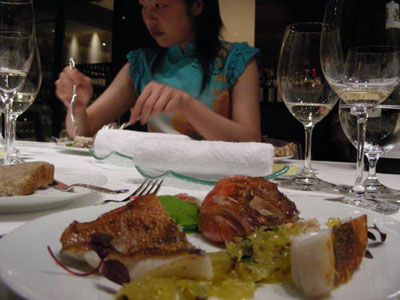Gaining his third star, 35-year-old Pascal Barbot confounded the theory that stars require cash with his modest 25-seat L'Astrance restaurant in Paris.
With the local dining scene blossoming into exciting new waters, the city continues to attract top talent from around the world coming to get a hands-on feel of the kitchens in Shanghai.
This year has already seen top chefs from Australia and America, among other places, join the talented ranks of cooks plying the increasing-sophisticated restaurants here in delivering top-notch dining experiences that leave food lovers drooling for weeks.
Last week, Michelin three-star chef Pascal Barbot dropped in for a visit and created two outstanding meals as part of a promotional tour in conjunction with French dairy company President and local fine food distributor Sinodis.
Held at La Platane, the exceptional classical French eatery run by Singaporean star chef Justin Quek, Frenchman Barbot impressed the city's top chefs with his repertoire of simple yet exquisite fare that tantalized the senses and refreshed weary palates.
As these promotions go, the L'Astrance chef was also called upon to do a cooking demonstration highlighting the superior qualities of President dairy products.
The fresh-faced 35-year-old was lively in his presentation of four recipes that focused on milk and cream.
"Marketing for me is not just a job; it's important because I get to travel and learn from other places," said the Vichy native. "Every year I do one or two trips to train, and then I learn new techniques or flavors."
The fresh-faced, straightforward chef was awarded his third star in March, benefiting from a change in the Michelin system which has now done away with making expensive trappings mandatory in order to achieve the highest accolade.
This has allowed younger chefs with a firm focus on what goes on the plate to gain recognition for their craft.
"I focus on food and service, and I've learnt to be regular," said Barbot, who did not have to invest more in his kitchen between his first star (which he was awarded seven years ago) and his third. "It's very simple - no crazy boom-boom, no put-put."
While this undoubtedly makes more sense in French, the gist of his message was aptly demonstrated during his class. Extremely particular with his set up without being obsessive, Barbot showed a group of local sous chefs how to make panna cotta; an infused-sauce similar to Hollandaise; mushroom cappuccino; and petite Madeleine cake.
The first lesson he delivered was on what made good whipped cream. It is very important that the cream is kept very cold, and the key was to incorporate air at a very slow pace.
"It's like an emulsion - it's no good to go fast. When you go slowly, you get many small bubbles which are more stable, but if you go too fast the bubble are bigger. If one explodes, then it will leave a gap. This way you keep the cream delicate and it does not separate easily."
The chef also pointed out that over-whipped cream turns to butter as the mixture separates.
As the recipe called for the cream to be mixed with cream and milk, sugar and gelatin (soaked in cold water overnight to remove the odor), it was important to keep the whipped cream soft as similar textures mix more easily.
The next recipe was a simple sauce that involved infusing rosemary into cooked butter, straining, and then incorporating egg yolks.
As the wonderful aroma of fresh rosemary wafted around the room, Barbot called upon an eager member of the audience to assist.
"When I look for an apprentice, the most important thing is that he is polite, smiling, respectful and motivated."
After adding some lemon juice for acidic balance, he served the sauce over some grated green apples which delivered an intense, sensational flavor combination that shot rockets across the mouth.
Compared to the first two offerings, the mushroom cappuccino was less labor-intensive but more time consuming.
After crushing the fungi in an industrial blender, he only added a single glass of water to maximize the taste of the mushrooms. He then added cream and cooked for some time at 60 degrees Celsius.
"Every chef needs to cook with fat, like butter or oil. Fat keeps a good perfume and retains more flavors."
Finally, the chef from the 25-seater Parisian restaurant showed all in attendance how to make little Madeleine cakes.
The key was once again in the butter, which was cooked till liquefied then cooled with some honey. After being mixed with almond powder, flour, baking powder, egg white and icing sugar, the final batch was left overnight and baked for six minutes at 220 degrees Celsius.
Result? A small, fluffy tidbit that was just sweet enough without being overwhelming.
The class was not so much a demonstration of Barbot's prowess in the kitchen but more on the reliable products offered by President.
However, it was still worth attending to see how such a celebrated chef works, and refreshing to find he was not the typical stuffy gastronomist many top chefs tend to be.
While the message was not quite as fluffy as the gist of the animated feature film "Ratatouille" and its adage "anyone can cook," Barbot was able to take a lot of the mystique out of the so-called Three-star cult and prove that passion and dedication to quality can take on pomp and splendor any day and still come out trumps.
(Shanghai Daily November 8, 2007)


